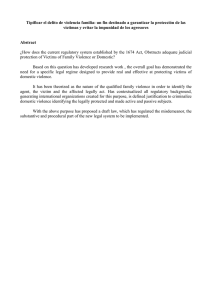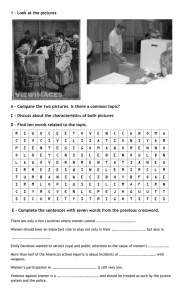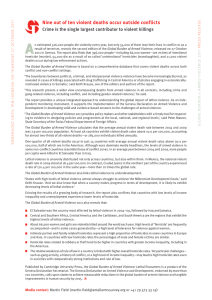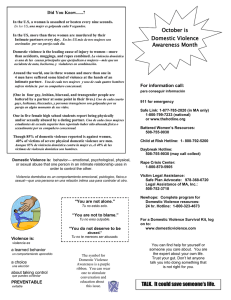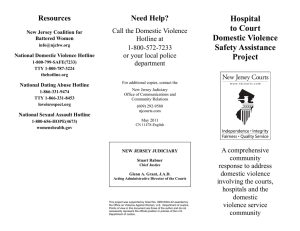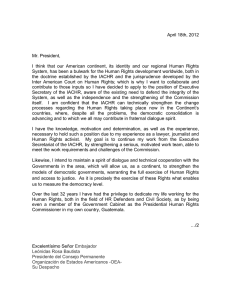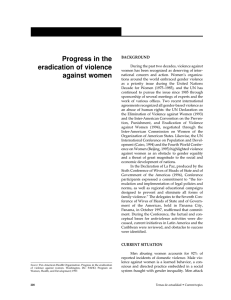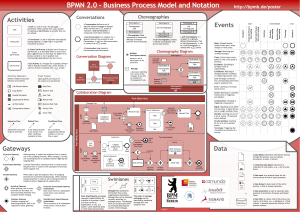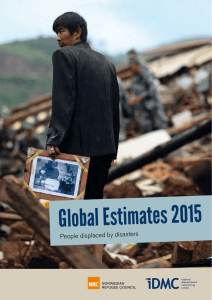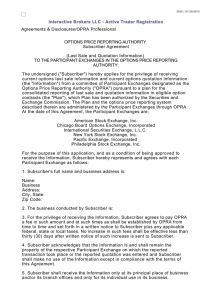Central Americans Displaced by Criminal Violence: A
Anuncio
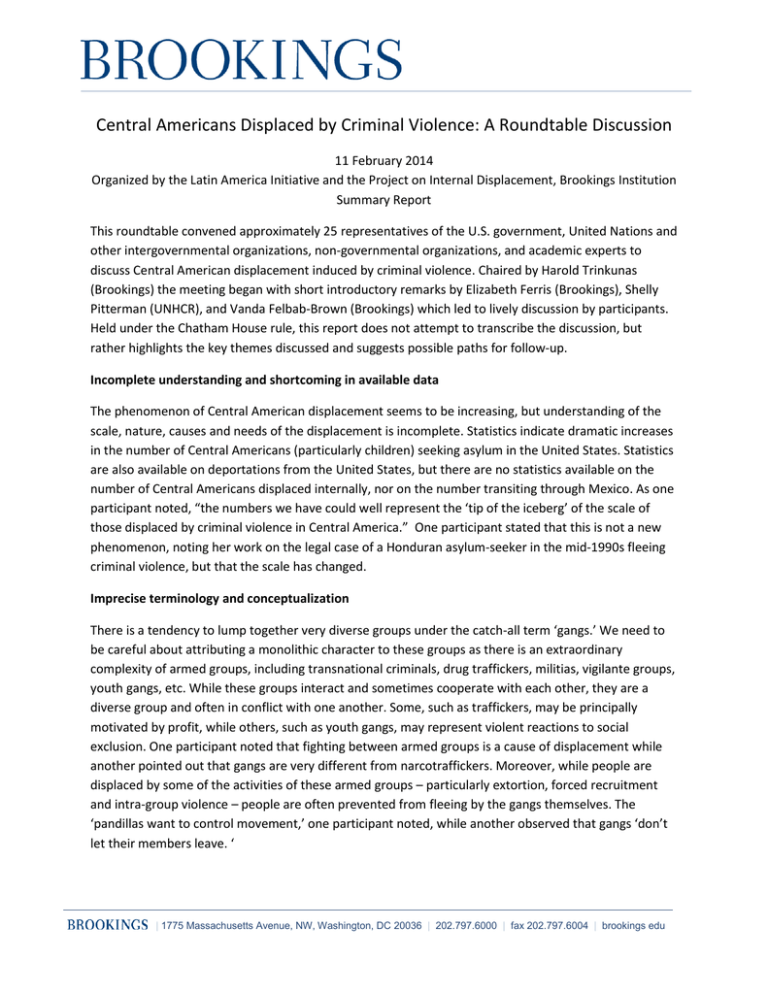
Central Americans Displaced by Criminal Violence: A Roundtable Discussion 11 February 2014 Organized by the Latin America Initiative and the Project on Internal Displacement, Brookings Institution Summary Report This roundtable convened approximately 25 representatives of the U.S. government, United Nations and other intergovernmental organizations, non-governmental organizations, and academic experts to discuss Central American displacement induced by criminal violence. Chaired by Harold Trinkunas (Brookings) the meeting began with short introductory remarks by Elizabeth Ferris (Brookings), Shelly Pitterman (UNHCR), and Vanda Felbab-Brown (Brookings) which led to lively discussion by participants. Held under the Chatham House rule, this report does not attempt to transcribe the discussion, but rather highlights the key themes discussed and suggests possible paths for follow-up. Incomplete understanding and shortcoming in available data The phenomenon of Central American displacement seems to be increasing, but understanding of the scale, nature, causes and needs of the displacement is incomplete. Statistics indicate dramatic increases in the number of Central Americans (particularly children) seeking asylum in the United States. Statistics are also available on deportations from the United States, but there are no statistics available on the number of Central Americans displaced internally, nor on the number transiting through Mexico. As one participant noted, “the numbers we have could well represent the ‘tip of the iceberg’ of the scale of those displaced by criminal violence in Central America.” One participant stated that this is not a new phenomenon, noting her work on the legal case of a Honduran asylum-seeker in the mid-1990s fleeing criminal violence, but that the scale has changed. Imprecise terminology and conceptualization There is a tendency to lump together very diverse groups under the catch-all term ‘gangs.’ We need to be careful about attributing a monolithic character to these groups as there is an extraordinary complexity of armed groups, including transnational criminals, drug traffickers, militias, vigilante groups, youth gangs, etc. While these groups interact and sometimes cooperate with each other, they are a diverse group and often in conflict with one another. Some, such as traffickers, may be principally motivated by profit, while others, such as youth gangs, may represent violent reactions to social exclusion. One participant noted that fighting between armed groups is a cause of displacement while another pointed out that gangs are very different from narcotraffickers. Moreover, while people are displaced by some of the activities of these armed groups – particularly extortion, forced recruitment and intra-group violence – people are often prevented from fleeing by the gangs themselves. The ‘pandillas want to control movement,’ one participant noted, while another observed that gangs ‘don’t let their members leave. ‘ | 1775 Massachusetts Avenue, NW, Washington, DC 20036 | 202.797.6000 | fax 202.797.6004 | brookings edu There was also considerable discussion on the implications of the terminology used for our understanding of the problem. One participant said that using the term ‘gang violence’ has consequences by ignoring the transnational nature of these armed groups; in a sense they are urban guerrillas. Others expressed reservations about the use of terms such as guerillas since it misleads as to the nature of the violence and motivations of armed actors. Another noted that when we speak in terms of gangs and criminal violence, it ‘inspires our worst fears about who is crossing our borders.’ Still another suggested that we should use the term ‘armed actors’ as a catch-all phrase for these different groups. Mixed motivations While there are problems in the terminology used to characterize these armed groups, there are also difficulties in determining the primary motivations for migration. People flee criminal violence, but they also flee for economic reasons such as poverty and a lack of jobs. In fact, criminal violence can be a major source of decreased economic opportunities, contributing to be a person’s decision to move. As several reminded the group, Central Americans in rural areas also leave because of conflicts over land. In some cases, these land conflicts are brought about by drug cartels; in others, it is businesses or economic interests seeking to acquire land who push people off their property. As one participant observed, the categories of people we are trying to help do not fall nicely into our institutional categories of economic migrants (presumed to be voluntary in our legal systems) or asylum-seekers (presumed to be forced). Moreover, as one participant observed, “it’s not just gangs which are transnational in nature, now we also have transnational families” and these inter-relationships influence decisions to move. Interrelationships between internal and cross-border displacement One of the central themes in the discussion was the need for better documentation of displacement as it takes place across borders, within state boundaries, and even within urban areas. There are newspaper reports and anecdotal evidence that people fleeing criminal violence first seek protection in another part of their country, often with family members, and may be displaced multiple times internally before setting out for other countries. As people are displaced internally, from rural to urban areas for example, they may be leaving territory controlled by one armed actor and entering that of an equally threatening group. Because they cannot find protection within their country, they seek protection in another one. As one participant noted, local governments need to increase their capacity to document the level of needs of their populations and respond to those needs. The lack of national protection draws attention to shortcomings of governmental policies to protect and assist internally displaced persons (IDPs). It also raises larger questions about how to reduce levels of violence, strengthen rule of law, and reform security forces and juvenile justice systems. For example, UNDP released a study recently that included surveys of prison inmates, finding that most of them had left home before the age of 15. Governmental ‘mano dura’ or iron fist policies have led to an increase in the number of those incarcerated. As many gangs in Central America operate both within and outside prisons, inmates are able to organize, strengthen their networks and improve their operations. Unless 2 better policing within the system happens, the prisons will perpetuate the problem. Several participants drew connections between criminal violence, displacement and violence-prevention within the region, noting the lack of a long-term strategy. Deportations and transit: poorly understood connections A number of participants mentioned the still poorly understood relationship between deportations from the United States and criminal violence and displacement in Central America. Nor do we understand the role of Mexico in Central American displacement. While there has been considerable attention to the front end (criminal violence) and the back end (asylum/deportation), one contributor noted that we really do not understand the middle piece – what is happening to people in transit. We need to look more closely at Mexico, one participant urged, which is at the same time a country of origin, destination and transit. The Mexican government is clamping down on its southern border, one participant asserted, because of the fear that Central American migrants traveling to the U.S. will be stopped at the northern border and remain in Mexico. One participant noted that the fact that children crossing from Guatemala into Mexico report being threatened at the border is evidence of the transnational nature of criminal groups. Particular vulnerabilities of the displaced While there is some research that indicates that Central Americans arriving in the U.S. report greater protection needs, there is a lack of understanding about the needs and vulnerabilities of the displaced. The number of Central American children in U.S. detention is predicted to reach 60-74,000 this year, but as one participant noted, this increase in the number of children arriving may represent the ‘canary in the coalmine’ and presage a larger movement of adults in the future. Children interviewed by UNHCR indicate that both the scale and intensity of criminal violence are increasing. Another indicated that those who have been displaced are particularly vulnerable to exploitation. Still another noted that a lack of population movement may not denote an improved situation, but rather may indicate that people are trapped as it becomes more dangeroU.S. to leave gangs or gang-controlled territories. Some participants further noted that among the vulnerabilities of the displaced is the loss of access to their main economic asset, which is their home or their land. U.S. policy matters U.S. policies of deporting Central Americans seem to have a negative impact on criminal violence, although (as noted above) that relationship is poorly understood. The response by some agencies in the United States has been to classify the dramatic increase in Central American arrivals as motivated by economic need. On the other hand, USAID is increasingly emphasizing the need for violence-prevention and rehabilitation in the region. The U.S. system for processing displaced persons who cross the border illicitly is not designed to differentiate among motives for flight. Moreover, since the act of crossing the border criminalizes displaced persons, they become more vulnerable to exploitation or violence by illicit actors because they cannot seek protection from the authorities. 3 U.S. policies toward the region have emphasized Central American security, but the relationship with displacement/migration has not been adequately addressed. The decentralization of targeted extortion and kidnapping has occurred as the U.S. and Mexico have adopted policies of going after the highestlevel gang members. However, when top leaders are removed, it then becomes more likely that midlevel members of the organization will take over territories and split away. This leads to a proliferation of illicit armed actors, especially in communities without strong rule of law. Several participants noted the relevance of the issue to U.S. immigration reform and explained that domestic politics of migration and foreign policy implications of displacement are frequently at odds. And yet as one participant insisted, although U.S. policy matters, it is important to recognize the role of national governments in the region in addressing the violence provoking this large-scale movement of people. Another participant noted that it was important to consider the intersection of the debates on protection and reform of the systems designed to address displaced persons, as well as the larger foreign and domestic politics debates about migration. Opportunities for follow-up While expressing appreciation for this seminar, participants noted that more work is needed across the following issues: 1. Comprehensive data collection: More data is needed to understand all stages of the issue ranging from initial displacement within countries to better information on those in transit, and developing a more nuanced understanding of motivations for flight. Improved data would support all other objectives identified by seminar participants. 2. Nuanced typologies of the actors involved: This would allow for an improved understanding of the factors motivating both violent armed actors and displaced Central Americans. 3. Effective state interventions: Additional information is needed on what programs have actually improved governance and reduced displacement. There is a sense that while many different policies have been tried by states and by their international partners, ranging from addressing root causes to ‘mano dura’ policies, our understanding of what does and does not work is still inadequate. This is also true in the areas of juvenile justice reform and programs for at-risk youth where further work is needed to assess their impact on the protection of populations to minimize need for displacement, provide security for those in transit, and rehabilitate armed actors so as to reduce the violence. 4. Long-range outcomes of rehabilitation and assistance programs: Participants noted that little research has been done on what happens in the long-term following state interventions to ameliorate the violence and displacement. Several participants indicated that there may be opportunities to further discuss and improve awareness of this issue. In particular, the 30th anniversary of the Cartagena Agreement in July 2014 may be an appropriate moment to draw additional attention to the issue. 4
